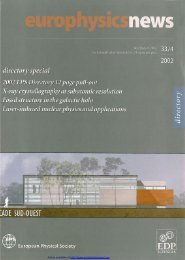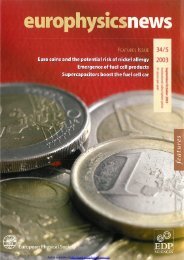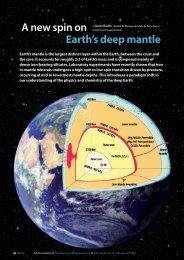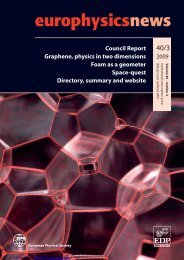PDF (11.37 MB) - Europhysics News
PDF (11.37 MB) - Europhysics News
PDF (11.37 MB) - Europhysics News
You also want an ePaper? Increase the reach of your titles
YUMPU automatically turns print PDFs into web optimized ePapers that Google loves.
Rutherford’s model of the atom<br />
Rutherford published his model of the atom [1] in<br />
1911 as an interpretation of the α-scattering work carried<br />
out by Geiger and Marsden [3] two years earlier.<br />
�e puzzle centred on finding a convincing explanation<br />
for the small fraction of α particles (around 1 in<br />
20,000) which were deflected through large angles,<br />
a�er passing through gold foil only 0.00004 cm thick.<br />
He argued that the probability of occasional largeangle<br />
scatters was inconsistent with multiple small angle<br />
scattering, and could only be explained by a single scattering<br />
event. �is required an“intense electric field”and<br />
led him to propose his model of an atom with a charge<br />
of ±Ne at its centre surrounded by a uniformly distributed<br />
sphere of the opposite charge.<br />
His arguments did not depend on the charge at the centre,<br />
but he chose the correct sign: “...the main deductions of<br />
the theory are independent of whether the central charge<br />
is supposed to be positive or negative. For convenience,<br />
the sign will be assumed to be positive.” He was aware that<br />
there were unanswered questions about how such a structure<br />
could exist: “�e question of the stability of the<br />
atom proposed need not be considered at this stage…”<br />
�ese questions were only fully answered much later.<br />
Using a reasonable estimate for the nuclear charge he<br />
calculated the distance of closest approach (~34 fm) for<br />
a typical head-on α particle to be completely stopped<br />
and provided the first ever order-of-magnitude estimate<br />
of the size of the nucleus. He showed that the trajectory<br />
taken by an α particle was hyperbolic and related the<br />
angle of deviation δ to the perpendicular distance b between<br />
the line of approach and the centre of the nucleus.<br />
He showed the scattering probability was proportional<br />
to cosec 4 (δ/2) and inversely proportional to the 4 th<br />
power of velocity. An important test of his model was<br />
to calculate the dependence of the relative number of<br />
scattered particles n on the atomic weight A. �e ratio<br />
n/A 2/3 should be constant. �e measured values for eight<br />
elements between Al and Pb ranged from 208 to 250<br />
with an average of 233. He concluded: “Considering the<br />
difficulty of the experiments, the agreement between<br />
theory and experiment is reasonably good.”<br />
Following the publication of his ground-breaking paper<br />
[1], Rutherford worked closely with other leading physicists<br />
of the day.Niels Bohr visited Manchester in 1912 and<br />
again 1914-16. Bohr’s model of stationary non-radiating<br />
electron orbits [4] added credence to Rutherford’s atom<br />
and answered the question of why the electrons do not<br />
fall into the nuclear core. Subsequent developments in the<br />
theory of quantum mechanics gave this an even sounder<br />
footing.However,understanding the small size and strong<br />
binding of the nucleus would have to wait till the 1930s,<br />
when the neutron was discovered and Yukawa first described<br />
the strong attractive force binding neutrons and<br />
protons together in terms of meson exchange.<br />
� fig. 1:<br />
Photograph of<br />
Hans geiger (left)<br />
&ernestrutherford<br />
(right) in their<br />
laboratory at<br />
manchester university<br />
circa 1908.<br />
� fig. 2: The α<br />
particle, experiencing<br />
an inverse<br />
square repulsive<br />
force, follows a<br />
hyperbolic trajectory<br />
(green) as it<br />
approaches the<br />
nucleus located<br />
at S, the external<br />
focus of the<br />
hyperbola. it<br />
enters along the<br />
asymptotic direction<br />
Po (red)<br />
reaching its closest<br />
approach<br />
d=Sa at the apse<br />
of the hyperbola<br />
before exiting<br />
along the second<br />
asymptote oP’.<br />
The angle of deviation<br />
δ=π-2θ<br />
depends on the<br />
energy of the<br />
alpha particle<br />
and its impact<br />
parameter b=Sn.<br />
EPN 42/5 19










